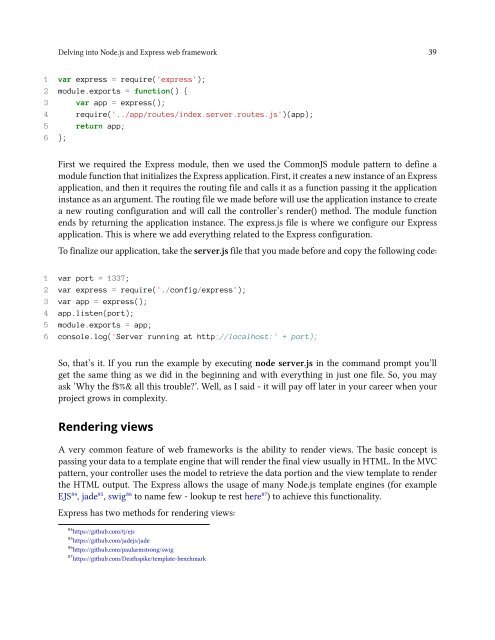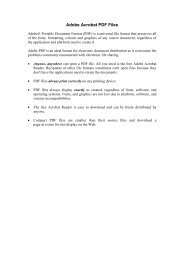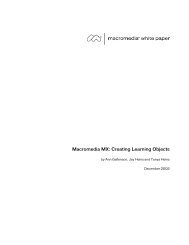Mittwoch, 18. Mai, 2016
You also want an ePaper? Increase the reach of your titles
YUMPU automatically turns print PDFs into web optimized ePapers that Google loves.
Delving into Node.js and Express web framework 39<br />
1 var express = require('express');<br />
2 module.exports = function() {<br />
3 var app = express();<br />
4 require('../app/routes/index.server.routes.js')(app);<br />
5 return app;<br />
6 };<br />
First we required the Express module, then we used the CommonJS module pattern to define a<br />
module function that initializes the Express application. First, it creates a new instance of an Express<br />
application, and then it requires the routing file and calls it as a function passing it the application<br />
instance as an argument. The routing file we made before will use the application instance to create<br />
a new routing configuration and will call the controller’s render() method. The module function<br />
ends by returning the application instance. The express.js file is where we configure our Express<br />
application. This is where we add everything related to the Express configuration.<br />
To finalize our application, take the server.js file that you made before and copy the following code:<br />
1 var port = 1337;<br />
2 var express = require('./config/express');<br />
3 var app = express();<br />
4 app.listen(port);<br />
5 module.exports = app;<br />
6 console.log('Server running at http://localhost:' + port);<br />
So, that’s it. If you run the example by executing node server.js in the command prompt you’ll<br />
get the same thing as we did in the beginning and with everything in just one file. So, you may<br />
ask ‘Why the f$%& all this trouble?’. Well, as I said - it will pay off later in your career when your<br />
project grows in complexity.<br />
Rendering views<br />
A very common feature of web frameworks is the ability to render views. The basic concept is<br />
passing your data to a template engine that will render the final view usually in HTML. In the MVC<br />
pattern, your controller uses the model to retrieve the data portion and the view template to render<br />
the HTML output. The Express allows the usage of many Node.js template engines (for example<br />
EJS⁸⁴, jade⁸⁵, swig⁸⁶ to name few - lookup te rest here⁸⁷) to achieve this functionality.<br />
Express has two methods for rendering views:<br />
⁸⁴https://github.com/tj/ejs<br />
⁸⁵https://github.com/jadejs/jade<br />
⁸⁶https://github.com/paularmstrong/swig<br />
⁸⁷https://github.com/Deathspike/template-benchmark
















